Have you been wondering which plants to incorporate into your south-facing slope in Australia? If you’re looking to transform that often-overlooked part of your garden into a thriving landscape, you’ve come to the right place. In this article, we’ll delve into the unique conditions a south-facing slope presents and provide a list of plants will thrive there.

If the sun is rising in the east in this photo, that would make the buxus hedge on the southern side of the house. https://www.shutterstock.com/image-photo/australian-colonial-sandstone-cottage-house-surrounded-686349745
Understanding a South-Facing Position
Sunlight Patterns
In the Southern Hemisphere, south-facing position receive less direct sunlight compared to north-facing ones. This is due to the trajectory of the sun, which travels higher in the northern part of the sky during summer but remains relatively low in winter. Consequently, areas on south-facing slopes and on the south side of structures can be cooler and shadier, especially during the winter months.
South-facing slopes receive less sunlight than flat ground and north-facing slopes, even when they are not in shade. If your plants are on a slope, every hour of sunlight counts for a little bit less, and the steeper the slope the more diminished is the amount of sunlight. The sun is much brighter during the middle of the day and the afternoon than it is in the morning.
Depending on the specific space, a south-facing position in the garden could be heavily shaded by structures, or it could receive at least 4 hours of quality sunlight throughout the day. The plants listed at the end of the article each have differing sunlight requirements, but can all thrive in a south-facing position.
Soil Moisture and Temperature
The reduced sunlight means these areas retain moisture longer, which can be advantageous during Australia’s hot summers. However, the soil may take longer to warm up in the spring, potentially delaying the growing season for some plants. Southern positions may also experience heavy shade in winter, and full sun in summer – depending on the direction of objects casting shade.
Understanding Light Conditions: Key Terms for Gardeners
When choosing plants for a south-facing aspect, you need to understand what the light levels specified on the plant labels each mean. Here’s a breakdown of common terms used to describe the full spectrum of sunlight conditions:
- Full Sun: Full sun refers to areas that receive at least six hours of direct sunlight per day.
- Part Sun (or Partial Sun): Part sun typically means an area that receives between four to six hours of direct sunlight each day. It often includes a mix of direct sun and shade throughout the day.
- Part Shade (or Partial Shade): Part shade indicates a location that gets between two to four hours of direct sunlight per day, often during the cooler parts of the day, such as early morning or late afternoon.
- Light Shade: A position which is open to the sky but shaded by an obstacle. I personally treat “light shade” the same as I treat “part shade” – if the plant has between four to six hours, you’ve ticked the box.
- Moderate Shade: Moderate shade describes areas that receive minimal direct sunlight, usually less than two hours a day, with the rest of the time spent in indirect light.
- Heavy Shade: Heavy shade refers to areas that receive very little to no direct sunlight throughout the day. These areas are often found under dense tree canopies, beneath structures, or on the south side of buildings where sunlight is entirely blocked.
- Dappled Light (or Filtered Light): Dappled light occurs when sunlight filters through overhead foliage, producing a pattern of light and shadow on the ground.
- Morning Sun: Morning sun refers to areas that receive direct sunlight in the early part of the day, typically until about noon, followed by shade in the afternoon.
- Afternoon Sun: Afternoon sun indicates locations that receive direct sunlight from noon onwards. This period of sunlight is more intense and can be hotter.
Best Plants for South-Facing Positions
Selecting plants that are adapted to the specific conditions of a south-facing slope is crucial for creating a successful garden. Here are some of the best native Australian plants well-suited for these cooler, shaded environments, each with their own light requirements.
Strappy Plants
Blaze™ Dianella tasmanica ‘NPW2’ PBR
Blaze™ Dianella is a strappy leaf plant known for its exceptional heat tolerance and striking deep purple foliage that remains vibrant for most of the year. It serves as an excellent alternative to phormiums and cordylines due to its resilience and aesthetic appeal.
Size
This plant maintains a compact and orderly growth habit, reaching approximately 45 cm in height and width.
Sunlight Preferences
Blaze™ Dianella thrives in a range of light conditions from full sun to heavy shade. For areas like Sydney and further north, it performs best in light to heavy shade and can tolerate full sun if located near the coast.
Soil Preferences
This plant is adaptable to different soil types, including sandy to clay soils, but it should be avoided in very poor soils. To ensure optimal growth, plant it in well-mulched gardens using chunky mulch.
Landscape Uses
Blaze™ Dianella is versatile and can be used in various landscaping applications such as:
- Roadsides
- Mass plantings
- Feature plantings
- Gardens
Care Practices
For the best results, follow these care practices:
- Water as required for 8-13 weeks until the plant is established.
- Ensure the crown or base of the plant is not below the soil or mulch level.
- Use slow-release fertiliser in spring.
- Trim older leaves as needed and cut back halfway every 3-7 years, with more frequent pruning (every 3 years) enhancing its appearance.
States Where It Thrives
- NSW
- ACT
- VIC
- TAS
- SA
- WA

https://www.ozbreed.com.au/plant-ranges/strappy-leaf-plants/blaze-dianella/
Amethyst™ Liriope muscari ‘LIRTP’ PBR
Amethyst™ Liriope is a compact plant known with deep purple flowers that sit well above the dark green foliage. The flowers are long-lasting and held high throughout the summer months, adding vibrant colour to any garden – especially in the shade where it can be hard to get good sources of colour.
Size
This plant grows in strappy clumps up to 40cm high and wide.
Sunlight Preferences
Amethyst™ Liriope thrives in various light conditions from full sun to heavy shade, making it adaptable to both sun and shade, ideal for south-facing positions.
Soil Preferences
It is suited to a variety of soil types and should be planted in a well-mulched garden, with chunky mulch recommended for best results.
Landscape Uses
This versatile plant can be used in numerous landscaping settings such as:
- Mass plantings
- Rockeries
- Flower gardens
- Specimen planting
Care Practices
To ensure optimal growth, follow these care practices:
- Water as required for 8-13 weeks until the plant is established.
- Cut back to the ground every year for the best appearance, although new growth will cover discoloured leaves by spring or summer if pruning is not possible.
States Where It Thrives
- New South Wales
- Australian Capital Territory
- Queensland
- Victoria
- South Australia
- Western Australia
- Tasmania
- Northern Territory
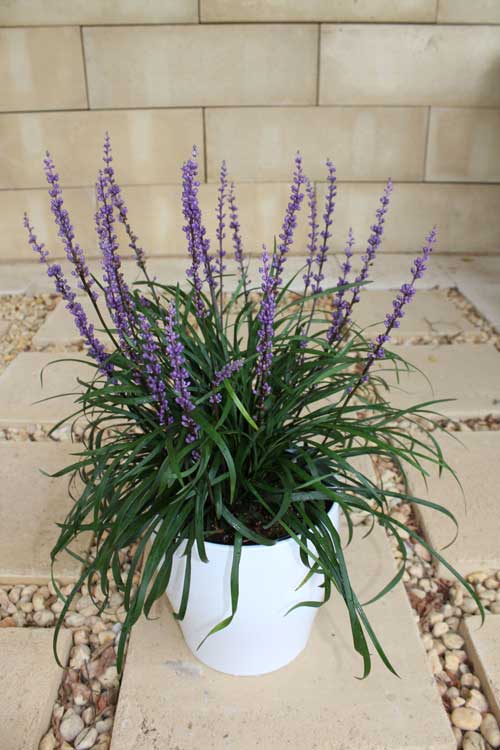
https://www.ozbreed.com.au/plant-ranges/strappy-leaf-plants/amethyst-liriope/
Tropic Cascade™ Lomandra hystrix ‘LHWP’ PBR
Tropic Cascade™ Lomandra is a compact strappy leaf plant with beautiful weeping foliage. It is well-suited to tropical and subtropical regions and can endure periods of wet feet, surviving temperatures down to -4°C.
Size:
This plant typically grows to a height and width of 60-80 cm. It maintains a smaller height if cut back every 3-4 years.
Sunlight Preferences:
Tropic Cascade™ Lomandra is suitable for south-facing positions which provide moderate to full sunlight.
Soil Preferences:
- Prefers planting in well-mulched gardens; chunky mulch is recommended but it can tolerate mulches with fines.
- Requires a reasonable dose of 8 to 9-month slow-release fertiliser, especially in nutrient-poor soils.
Landscape Uses:
Ideal for specimen or mass plantings in residential and commercial landscapes.
Care Practices:
- Water as required during the first 8-13 weeks until established. Occasional watering may be necessary for dry inland regions, Western Australia, and South Australia.
- Apply slow-release fertiliser in spring.
- Every 3-7 years, cut back to 30 cm above the ground for optimal appearance (pruning every 3 years is recommended for a better look).
Regions Where It Thrives:
- New South Wales (NSW)
- Queensland (QLD)
- Australian Capital Territory (ACT)
- Victoria (VIC)
- South Australia (SA)
- Western Australia (WA)
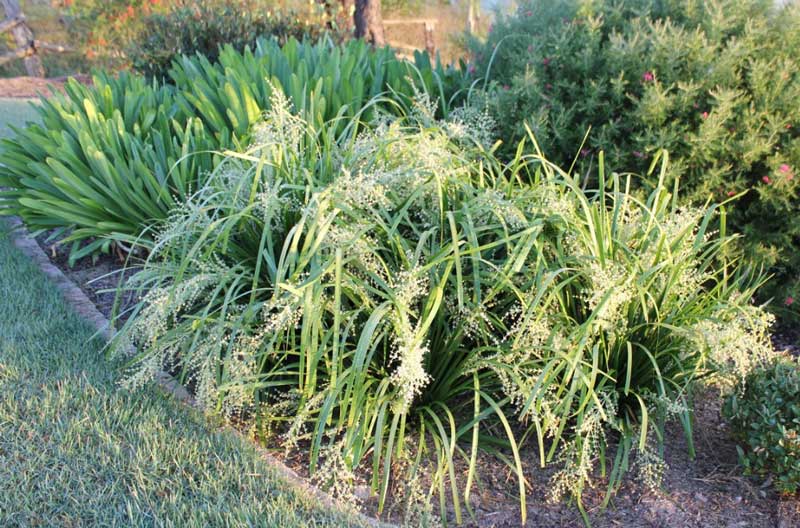
https://www.ozbreed.com.au/plant-ranges/strappy-leaf-plants/tropic-cascade-lomandra/
Small Shrubs, Ground Covers and Herbaceous Plants
Fire Bells™ Correa pulchella ‘COR11’ PBR Intended
FIRE BELLS™ Correa is a compact, dense ground cover ideal for small gardens and patios. It boasts vibrant red/orange flowers and requires minimal pruning to maintain its form.
Size:
This plant typically grows to about 30 cm in height and spreads to approximately 1.5 metres in width.
Sunlight Preferences:
FIRE BELLS™ Correa thrives in full sun to light shade.
Soil Preferences:
- Prefers reasonably drained soil but is adaptable to most soil types.
- Tolerates both drought and frost conditions.
Landscape Uses:
Perfect for bird-attracting gardens, as a dense ground cover in small gardens, or in containers for patios due to its compact growth and vibrant flowers.
Care Practices:
- Water as required during the first 8-13 weeks until established.
- Plant in a well-mulched garden, with chunky mulch recommended for optimal growth.
- Prune once a year to maintain a semi-compact habit or twice per year for a more manicured appearance.
- Use slow-release native fertiliser.
Regions Where It Thrives:
- Victoria (VIC)
- Australian Capital Territory (ACT)
- South Australia (SA)
- Western Australia (WA)
- Tasmania (TAS)
- Southern New South Wales (NSW)
- Sydney (in well-draining soils)
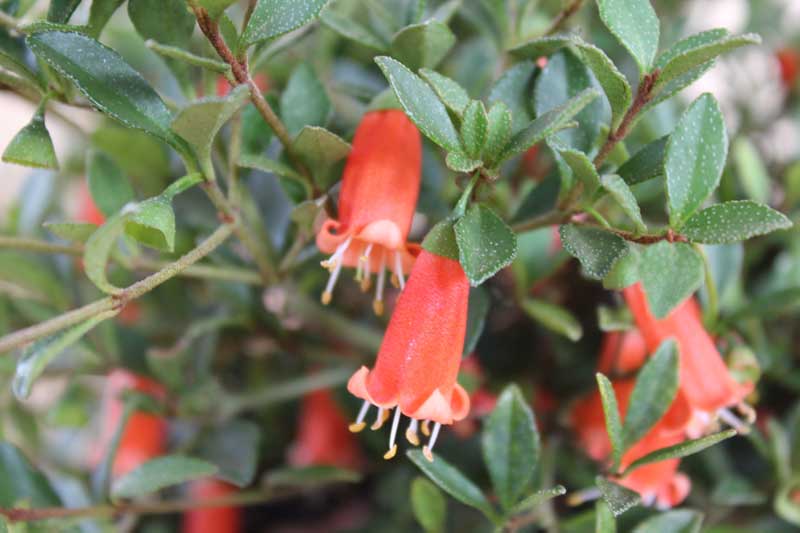
Pink Fusion™ Scaevola spp. ‘PFS200’ PBR Intended
PINK FUSION™ Scaevola is a resilient, flowering ground cover that thrives in landscape use. Distinguished from regular Scaevola varieties, it has been specifically bred for harsher Australian climates, with a compact and tight growth habit that requires minimal pruning. Notable for its elegant and abundant pink flowers, it can bloom all year round in optimal conditions. Its dense foliage acts as an effective weed barrier.
Size:
The plant’s spread varies with soil quality, extending up to 1.2 metres wide in fertile soils and approximately 80 cm in poorer soils. It can grow up to 30cm high.
Sunlight Preferences:
PINK FUSION™ performs well in full sun to light shade, doing well in south-facing positions that get at least 4 hours of direct sunlight.
Soil Preferences:
- Adaptable to various soil types, including harsh and poor soils.
- Tolerates frost, drought, and semi-wet feet conditions.
Landscape Uses:
Ideal for mass plantings, cottage gardens, and as a long-flowering ground cover lining the front of garden landscapes. It is particularly suited for areas requiring low maintenance and high durability.
Care Practices:
- Water as required during the first 8-13 weeks until established.
- Trim once a year to maintain a tidy appearance.
- Its hardy nature necessitates minimal ongoing maintenance.
Regions Where It Thrives:
Likely Australia-wide.
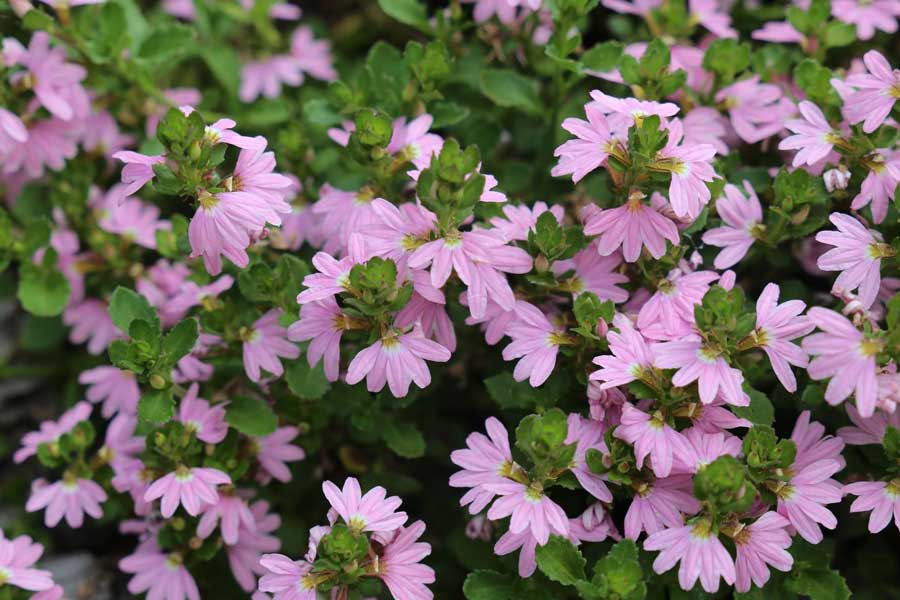
https://www.ozbreed.com.au/plant-ranges/native-shrubs-groundcovers/pink-fusion/
Little Phil™ Philodendron species ‘PHIL01’ PBR
Little Phil™ Philodendron is a compact form, ideal for shady areas or as an indoor plant. Unlike the Xanado variety, it doesn’t elongate, making it perfect for table tops, window sills, and shaded south-facing positions. This versatile plant enhances both indoor and outdoor settings.
Size:
- Height: Approximately 40 cm
- Spread: Approximately 40 cm
Sunlight Preferences:
Little Phil™ Philodendron thrives in light to moderately heavy shade. It can live in full sun but does better when it has some shelter from the intense Australian sun to avoid leaf damage.
Soil Preferences:
- Drainage: Prefers well-drained soil enriched with organic matter.
- Mulch: A well-mulched garden with chunky mulch is recommended to maintain soil moisture and health.
Landscape Uses:
- Indoor Plant: Ideal for desks, tables, and window sills, making it a popular choice for office and home interiors.
- Garden Use: Suitable for shaded south-facing landscape gardens and green walls.
- Patio Plant: An excellent companion for patios, particularly in colder parts of Australia where it should be kept indoors or well-sheltered during extreme weather.
Care Practices:
- Watering: Water as required for 8-13 weeks until established.
- Fertilisation: Use slow-release fertiliser in spring if necessary.
- Leaf Management: Remove older leaves as needed to keep the plant looking fresh and healthy.
Regions Where It Thrives:
- New South Wales (NSW)
- Victoria (VIC)
- Tasmania (TAS)
- South Australia (SA)
- Western Australia (WA)
- Queensland (QLD)
- Northern Territory (NT)
- Australian Capital Territory (ACT)
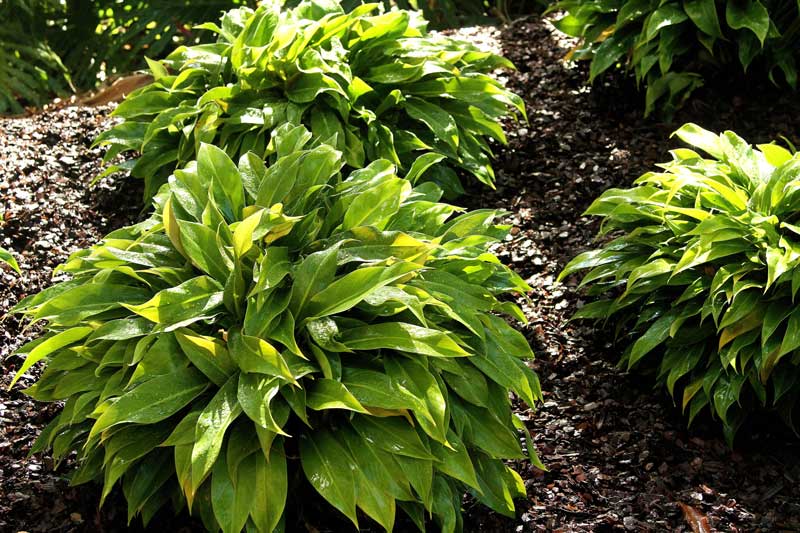
https://www.ozbreed.com.au/plant-ranges/hardy-exotic-range/little-phil/
Low to Medium-Sized Shrubs
Blush™ Nandina domestica ‘AKA’ PBR
BLUSH™ Nandina is a hardy, low shrub with vibrant red foliage that endures for nine months of the year. A medium dwarf Nandina that does not spread from seed, it’s ideal for gardeners keen to avoid spreading weeds. BLUSH™ Nandina features red new growth during spring and autumn, while other Nandinas remain green, making it a striking ornamental plant with extended seasonal interest.
Size:
- Height: Approximately 60-70 cm
- Width: Approximately 60-70 cm
Sunlight Preferences:
Thrives in full sun to moderate shade, making it suitable for south-facing positions that only receive 2 hours of direct sunlight each day.
Soil Preferences:
- Soil Type: Prefers well-drained soil.
- Mulch: Plant in a well-mulched garden with chunky mulch recommended to maintain soil moisture and health.
Landscape Uses:
- Ornamental Shrub: Ideal as a feature plant in garden beds due to its striking red foliage.
- Border Plant: Effective as a border or edging plant along pathways or garden edges.
- Container Plant: Suitable for container planting, adding vibrant colour to patios and balconies.
Care Practices:
- Watering: Water as required for 8-13 weeks until established.
- Fertilisation: Use slow-release fertiliser in spring if necessary.
- Pruning: Can be left unpruned or pruned to shape every three years if required.
- Mulching: Use chunky mulch to help retain soil moisture and promote healthy growth.
Regions Where It Thrives:
- New South Wales (NSW)
- Victoria (VIC)
- Tasmania (TAS)
- South Australia (SA)
- Western Australia (WA)
- Queensland (QLD)
- Northern Territory (NT)
- Australian Capital Territory (ACT)

https://www.ozbreed.com.au/plant-ranges/hardy-exotic-range/blush-nandina/
Naringa™ Westringia hybrid ‘WES01’ PBR
NARINGA™ Westringia is a highly regarded medium-tall hedging plant known for its rapid establishment, tidy form, and abundant mauve flowers. It requires much less pruning compared to other Westringias. NARINGA™ Westringia offers a very fast-establishing hedge with a neat appearance and fewer pruning needs. It produces masses of mauve flowers, enhancing garden aesthetics.
Size:
- Pruned: Approximately 1 m high x 60 cm wide
- Unpruned: Approximately 2.2 m high x 1.5 m wide
Sunlight Preferences:
This plant thrives in full sun to part shade, making it suitable for south-facing positions that still receive a decent amount of sunlight.
Soil Preferences:
- Soil Type: Suits sandy to well-drained clay soils.
- Drainage: Avoid wet feet and depressed planting areas.
- Mulch: Plant in a well-mulched garden with chunky mulch recommended to maintain soil health and moisture.
Landscape Uses:
- Hedge: Ideal for creating a tidy, low-maintenance hedge.
- Natural Setting: Can be left unpruned for a natural, tidy form or pruned to shape as needed.
- Flower Bed: Enhances flower beds and borders with its stunning mauve blooms and structured growth.
Care Practices:
- Watering: Water as required for 8-13 weeks until established.
- Pruning: Requires pruning about half as much as other Westringias. In a natural setting, it may not need pruning at all. Prune 1-3 times a year after flowering to maintain a tidy hedge or desired shape.
- Mulching: Use chunky mulch to help retain soil moisture and health.
Regions Where It Thrives:
NARINGA™ Westringia performs well in the following states:
- New South Wales (NSW)
- Australian Capital Territory (ACT)
- Victoria (VIC)
- Tasmania (TAS)
- South Australia (SA)
- Western Australia (WA)
- South East Queensland (QLD) (Not suited to Northern QLD)
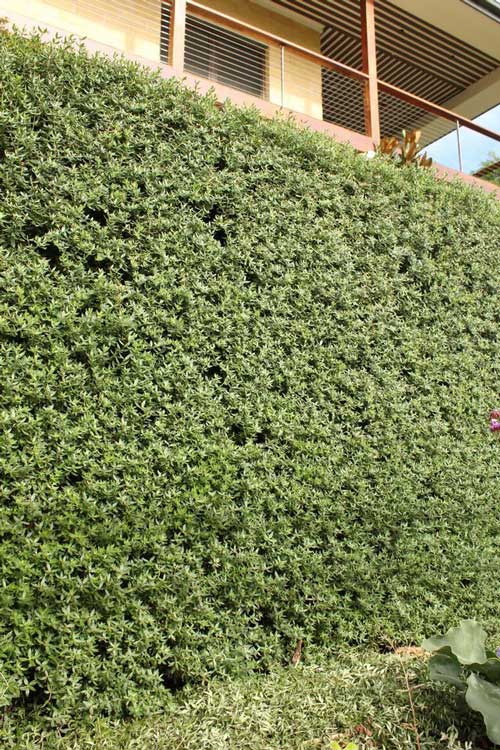
Coastal Pink™ Correa alba ‘COR10’ PBR
COASTAL PINK™ Correa is a medium shrub or hedge with a robust growth habit and pink flowers. It’s particularly well-suited for windy, slightly salty conditions, perfect for coastal landscapes and as a screen near salty pools. COASTAL PINK™ Correa is a new pink-flowered form of the popular coastal Correa alba that performs a lot better in non-humid areas, with much less die-back than common forms in Melbourne and Sydney.
Size:
- Height: Medium shrub size
- Width: Can be pruned to suit requirements, from a medium-sized shrub to a small fence-sized hedge
Sunlight Preferences:
Thrives in full sun to light shade, making it suitable for south-facing positions that receive at least 4 hours of direct sunlight.
Soil Preferences:
- Soil Type: Prefers reasonably drained soil but is adaptable to most soil types as long as it’s not in a humid climate.
- Drainage: Ensure decent drainage; avoid waterlogged conditions.
- Mulch: Plant in a well-mulched garden with chunky mulch recommended to maintain soil moisture and health.
Landscape Uses:
- Hedge: Can be shaped into a medium-sized hedge or a small fence-sized hedge.
- Landscape Filler: Acts as a coastal bird-attracting landscape filler between trees or when mass-planted.
- Coastal Gardens: Perfect for use in coastal gardens due to its tolerance to salt-laden winds.
Care Practices:
- Watering: Water as required for 8-13 weeks until established, after which it has low water requirements.
- Pruning: Prune once per year to maintain a semi-compact habit or twice per year for a really tidy appearance. Alternatively, allow the plant to express its natural shape without pruning.
- Fertilisation: Use slow-release fertiliser.
- Mulching: Use chunky mulch to help retain soil moisture and promote healthy growth.
Regions Where It Thrives:
COASTAL PINK™ Correa performs well in the following states:
- Victoria (VIC)
- Australian Capital Territory (ACT)
- South Australia (SA)
- Western Australia (WA)
- Tasmania (TAS)
- Southern New South Wales (Southern NSW)
- Sydney (in well-draining soils)

Larger Shrubs and Small Trees
Velvet Sky™ Metrosideros collina ‘MB01’ PBR
VELVET SKY™ Metrosideros is an eye-catching NZ Christmas bush with inky blue stems and blueish velvet foliage, making a striking statement as a hedge or specimen plant. The blue tones are more pronounced in cooler climates. VELVET SKY™ Metrosideros has an excellent compact form with dense growth, making it ideal for hedging, but it can also be grown as a small feature tree. It produces stunning red flowers that beautifully contrast with its blue foliage, creating a visually appealing addition to any garden.
Size:
- Height: 2-4 m
- Width: 1-3 m
- In cooler climates, the plant can be smaller.
Sunlight Preferences:
This plant tolerates full sun to part shade. For more vibrant inky blue stems, it is best planted in lightly shaded areas such as south-facing positions that receive at least 4 hours of direct sunlight.
Soil Preferences:
- Soil Type: Tolerates most soil types.
- Drainage: Avoid wet feet; plant in well-drained soil.
- Mulch: A well-mulched garden with chunky mulch is recommended to maintain soil moisture and health.
Landscape Uses:
- Hedge or Screen: Makes an excellent hedge or small screen due to its dense growth habit and compact form.
- Specimen Plant: Can also be used as a specimen plant to make a bold statement in the garden.
Care Practices:
- Watering: Water as required for 8–13 weeks until established.
- Fertilisation: Fertilise yearly with slow-release fertiliser.
- Pruning: Can be left unpruned for a natural hedge or pruned once a year for a tidier appearance.
- Mulching: Use chunky mulch to help retain soil moisture and promote healthy growth.
Regions Where It Thrives:
VELVET SKY™ Metrosideros performs well in the following states:
- South Queensland (Sth QLD)
- Northern New South Wales (Northern NSW)
- Sydney/Central New South Wales (SYD/Central NSW)
- Southern New South Wales (Southern NSW)
- Victoria (VIC)
- South Australia (SA)
- Western Australia (WA)
Further testing is required for Northern Queensland (Nth QLD). In cooler climates, protect the plant from frost.

https://www.ozbreed.com.au/plant-ranges/hardy-exotic-range/velvet-sky-metrosideros/
Straight and Narrow™ Syzygium australe ‘SAN01’ PBR Intended
STRAIGHT AND NARROW™ Syzygium is a slender, semi-compact, and dense Lilly Pilly that functions excellently as a feature tree, screen or hedge for tight planting areas. This psyllid resistant variety is perfect for constrained locations such as along fences and driveways, and is also suitable for topiary.
Size:
- Height: 5-8 m
- Width: 1-1.5 m
Sunlight Preferences:
Thrives in full sun to heavy shade, making it suitable for south-facing positions that receive very little sunlight. In fact, it’s one of the best low-light hedges available.
Soil Preferences:
- Soil Type: Suits moist, well-drained soil types.
- Mulch: Plant in a well-mulched garden with chunky mulch recommended to maintain soil moisture.
Landscape Uses:
- Screen or Hedge: Ideal for creating a screen or hedge in tight planting areas.
- Topiary: Works well for topiary due to its excellent growth response to pruning.
- Constrained Areas: Perfect for planting along fences and driveways.
Care Practices:
- Watering: Water as required for 8-13 weeks until established.
- Fertilisation: If necessary, use slow-release fertiliser in spring.
- Pruning: Prune twice yearly for a very tidy hedge or every 2-3 years as a wider screen plant.
- Mulching: Use chunky mulch to help retain soil moisture and promote healthy growth.
Regions Where It Thrives:
- Queensland (QLD)
- New South Wales (NSW)
- Victoria (VIC)
- South Australia (SA)
- Western Australia (WA)
- Australian Capital Territory (ACT) (if protected from frosts)
Conclusion
Gardening on a south-facing slope in Australia presents both challenges and opportunities. By understanding the unique conditions and selecting appropriate plants, you can create a beautiful, sustainable garden with plants that don’t wilt away.
Are you ready to transform your south-facing slope into a lush, vibrant garden? Start planning today and watch your landscape flourish!
